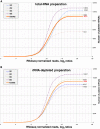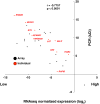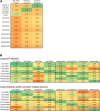The complex transcriptional landscape of the anucleate human platelet
- PMID: 23323973
- PMCID: PMC3722126
- DOI: 10.1186/1471-2164-14-1
The complex transcriptional landscape of the anucleate human platelet
Abstract
Background: Human blood platelets are essential to maintaining normal hemostasis, and platelet dysfunction often causes bleeding or thrombosis. Estimates of genome-wide platelet RNA expression using microarrays have provided insights to the platelet transcriptome but were limited by the number of known transcripts. The goal of this effort was to deep-sequence RNA from leukocyte-depleted platelets to capture the complex profile of all expressed transcripts.
Results: From each of four healthy individuals we generated long RNA (≥40 nucleotides) profiles from total and ribosomal-RNA depleted RNA preparations, as well as short RNA (<40 nucleotides) profiles. Analysis of ~1 billion reads revealed that coding and non-coding platelet transcripts span a very wide dynamic range (≥16 PCR cycles beyond β-actin), a result we validated through qRT-PCR on many dozens of platelet messenger RNAs. Surprisingly, ribosomal-RNA depletion significantly and adversely affected estimates of the relative abundance of transcripts. Of the known protein-coding loci, ~9,500 are present in human platelets. We observed a strong correlation between mRNAs identified by RNA-seq and microarray for well-expressed mRNAs, but RNASeq identified many more transcripts of lower abundance and permitted discovery of novel transcripts.
Conclusions: Our analyses revealed diverse classes of non-coding RNAs, including: pervasive antisense transcripts to protein-coding loci; numerous, previously unreported and abundant microRNAs; retrotransposons; and thousands of novel un-annotated long and short intronic transcripts, an intriguing finding considering the anucleate nature of platelets. The data are available through a local mirror of the UCSC genome browser and can be accessed at: http://cm.jefferson.edu/platelets_2012/.
Figures




Similar articles
-
Next generation sequencing analysis of human platelet PolyA+ mRNAs and rRNA-depleted total RNA.PLoS One. 2013 Dec 11;8(12):e81809. doi: 10.1371/journal.pone.0081809. eCollection 2013. PLoS One. 2013. PMID: 24349131 Free PMC article.
-
Transcriptome analysis of smut fungi reveals widespread intergenic transcription and conserved antisense transcript expression.BMC Genomics. 2017 May 2;18(1):340. doi: 10.1186/s12864-017-3720-8. BMC Genomics. 2017. PMID: 28464849 Free PMC article.
-
The human platelet: strong transcriptome correlations among individuals associate weakly with the platelet proteome.Biol Direct. 2014 Feb 14;9:3. doi: 10.1186/1745-6150-9-3. Biol Direct. 2014. PMID: 24524654 Free PMC article.
-
The role of circulating platelet transcripts.J Thromb Haemost. 2015 Jun;13 Suppl 1:S33-9. doi: 10.1111/jth.12922. J Thromb Haemost. 2015. PMID: 26149043 Review.
-
Platelet transcriptome: the application of microarray analysis to platelets.Semin Thromb Hemost. 2004 Aug;30(4):473-84. doi: 10.1055/s-2004-833482. Semin Thromb Hemost. 2004. PMID: 15354268 Review.
Cited by
-
MicroRNAs in platelet function and cardiovascular disease.Nat Rev Cardiol. 2015 Dec;12(12):711-7. doi: 10.1038/nrcardio.2015.101. Epub 2015 Jul 7. Nat Rev Cardiol. 2015. PMID: 26149483 Review.
-
Plasma growth factors maintain constitutive translation in platelets to regulate reactivity and thrombotic potential.Blood Adv. 2024 Mar 26;8(6):1550-1566. doi: 10.1182/bloodadvances.2023011734. Blood Adv. 2024. PMID: 38163324 Free PMC article.
-
Karyon: a computational framework for the diagnosis of hybrids, aneuploids, and other nonstandard architectures in genome assemblies.Gigascience. 2022 Oct 7;11:giac088. doi: 10.1093/gigascience/giac088. Gigascience. 2022. PMID: 36205401 Free PMC article.
-
Prospective, international, multisite comparison of platelet isolation techniques for genome-wide transcriptomics: communication from the SSC of the ISTH.J Thromb Haemost. 2024 Oct;22(10):2922-2934. doi: 10.1016/j.jtha.2024.06.017. Epub 2024 Jul 3. J Thromb Haemost. 2024. PMID: 38969303
-
A selective BCL-XL PROTAC degrader achieves safe and potent antitumor activity.Nat Med. 2019 Dec;25(12):1938-1947. doi: 10.1038/s41591-019-0668-z. Epub 2019 Dec 2. Nat Med. 2019. PMID: 31792461 Free PMC article.
References
-
- Jones CI, Garner SF, Angenent W, Bernard A, Berzuini C, Burns P, Farndale RW, Hogwood J, Rankin A, Stephens JC. et al.Mapping the platelet profile for functional genomic studies and demonstration of the effect size of the GP6 locus. Journal of thrombosis and haemostasis: JTH. 2007;5(8):1756–1765. doi: 10.1111/j.1538-7836.2007.02632.x. - DOI - PubMed
-
- Bray PF, Mathias RA, Faraday N, Yanek LR, Fallin MD, Herrera-Galeano JE, Wilson AF, Becker LC, Becker DM. Heritability of platelet function in families with premature coronary artery disease. Journal of thrombosis and haemostasis: JTH. 2007;5(8):1617–1623. doi: 10.1111/j.1538-7836.2007.02618.x. - DOI - PubMed
Publication types
MeSH terms
Substances
Grants and funding
LinkOut - more resources
Full Text Sources
Other Literature Sources

